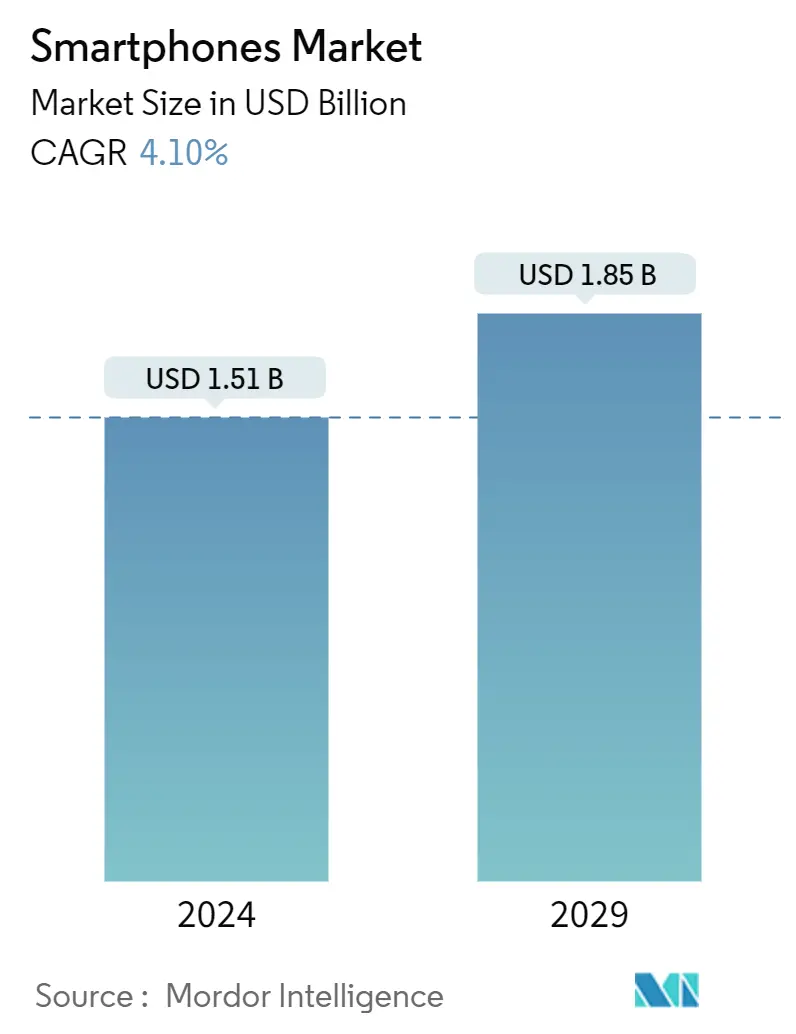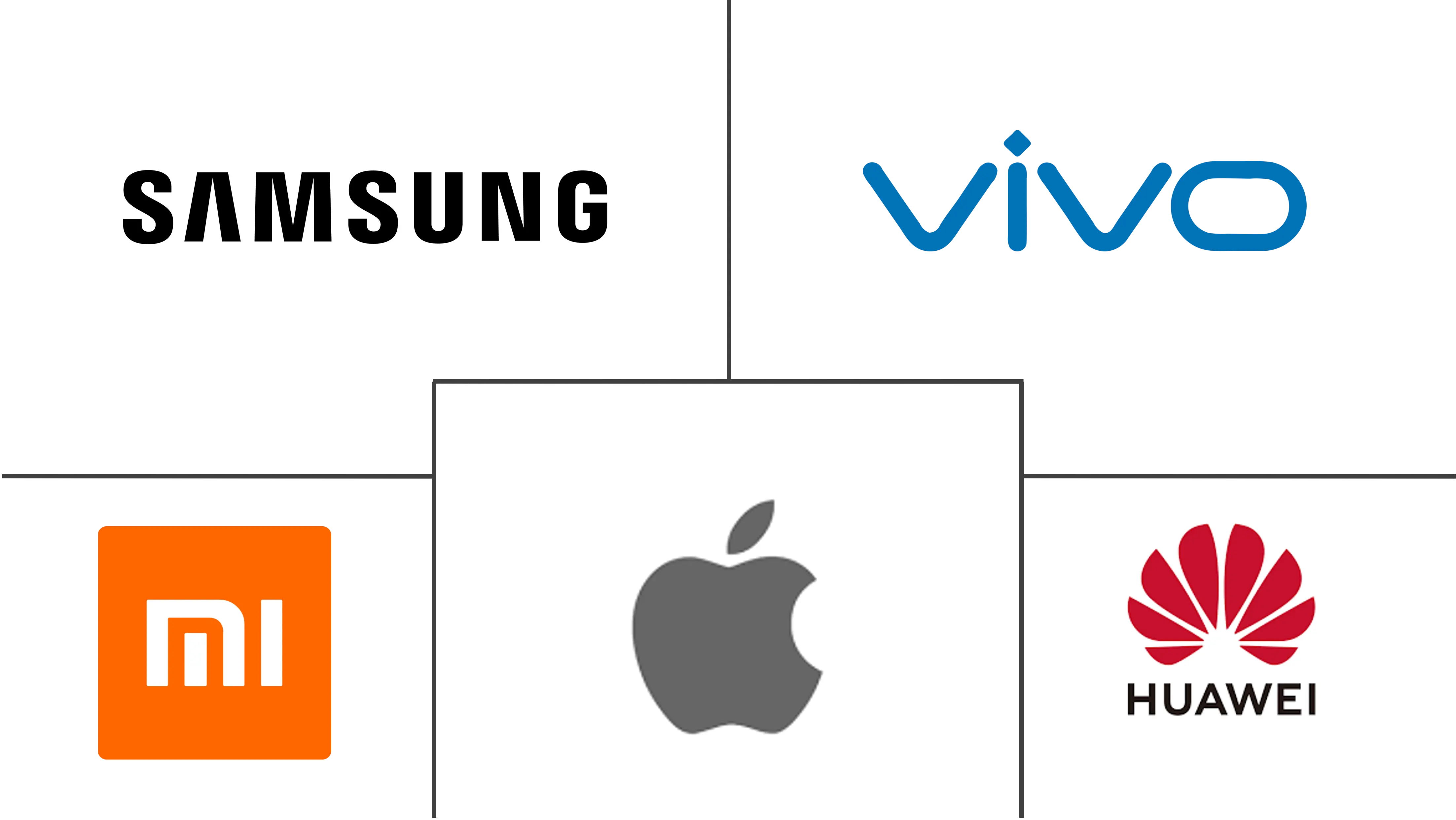Market Size of Smartphones Industry

| Study Period | 2019 - 2029 |
| Market Size (2024) | USD 1.51 Billion |
| Market Size (2029) | USD 1.85 Billion |
| CAGR (2024 - 2029) | 4.10 % |
| Fastest Growing Market | Middle East and Africa |
| Largest Market | Asia Pacific |
| Market Concentration | High |
Major Players
*Disclaimer: Major Players sorted in no particular order |
Smartphones Market Analysis
The Smartphones Market size is estimated at USD 1.51 billion in 2024, and is expected to reach USD 1.85 billion by 2029, growing at a CAGR of 4.10% during the forecast period (2024-2029).
Factors such as increasing disposable income, the development of telecom infrastructure, the emergence of budget-centric smartphones, and an increasing number of product launches contribute to the smartphone market growth in Asian countries.
• The smartphone industry has steadily developed and grown in market size and models. According to BankMyCell, by January 2024, there would be 6.93 billion mobile phone users worldwide, representing 85.74% of the world's population. The number of people who own a smart and feature phone is 7.41 billion, making up 91.68% of the world's population.
• The key players in the market are involved in strategic partnerships to improve their service offerings and remain competitive. In January 2024, Ncell introduced an enticing collaboration with Samsung for the pre-order launch of the Galaxy S24 series smartphones. As part of that partnership, Ncell is offering its users attractive bundled services and special facilities exclusively. The Ncell LUX number of their choice will be available to the initial 500 customers who pre-book a Samsung Galaxy S24 series smartphone.
• Consumer interest in 5G devices is growing. Thus, chipmakers are pushing manufacturers to include 5G chips in their new smartphone lineup.
• The government is taking appropriate actions on network development and expansion. For instance, in February 2023, the Central Government of India planned to set up 100 laboratories in engineering institutes all over India to develop 5G applications for different sectors.
• According to the budget documents for 2023-24, the Centre also provided INR 5.56 Crore (USD 680.48 Million) to set up a 5G test site. For the financial year 2023, the Centre for Development of Telematics and Research and Development of the Department of Telecommunications will receive INR 550 Crore (USD 673.14 Million), compared to INR 500 Crore (USD 611.95 Million) for the financial year 2022-23.
• The COVID-19 pandemic severely disrupted the smartphone market's balance between supply and demand. Since China is the global manufacturing center for most of these devices and components, and with the nationwide lockdown, the smartphone manufacturing sector has been adversely hit by delayed shipments and weakened development of next-generation products. The country also witnessed being choked off by suppliers, workers, and logistics networks. Moreover, consumer demand for smartphones, especially in the premium segment, declined due to customers' tendency to cut down on luxury spending and focus on essentials due to the pandemic.
• Smartphones are experiencing rapid growth due to various factors, such as lower product costs, improved handset design and functionality, the expansion of global mobile email and browsing services, the emergence of 4G and 5G network technologies, rising competition among mobile carriers, and the standardization and upgrading of operating systems.
• Smartphones played an incredibly important role amid the widespread coronavirus pandemic, and this continued even after the pandemic was over, as almost all government services, health, education, financial services, and so on went online, with smartphones serving as a more accessible and more affordable gateway to access these services.
Smartphones Industry Segmentation
Smartphones, with solid hardware capabilities, extensive mobile operating systems, more comprehensive software applications, internet, and multimedia functionality (music, videos, and gaming), alongside core phone functions such as voice calls and text messaging, are considered in the scope. Smartphones used for industrial purposes, or rugged phones, are not considered in the scope.
The smartphone market is segmented by operating system (Android, iOS) and geography (North America, Europe, China, Asia-Pacific (excluding China), Latin America, GCC, and Africa). The market sizes and forecasts regarding value (USD) for all the above segments are provided.
| By Operating Segment | |
| Android | |
| iOS |
| By Geography*** | |
| North America | |
| Europe | |
| China | |
| Asia | |
| Australia and New Zealand | |
| Latin America | |
| GCC | |
| Africa |
Smartphones Market Size Summary
The smartphone market is poised for steady growth over the forecast period, driven by factors such as increasing disposable income, advancements in telecom infrastructure, and the rise of budget-friendly smartphones. The industry has seen a surge in product launches, with key players engaging in strategic partnerships to enhance their offerings and maintain competitiveness. The growing consumer interest in 5G devices is prompting manufacturers to incorporate 5G technology into their new models, supported by government initiatives aimed at expanding network capabilities. Despite challenges posed by the COVID-19 pandemic, which disrupted supply chains and affected demand, the market has rebounded, with smartphones becoming essential tools for accessing online services across various sectors.
Asia-Pacific stands out as a significant market due to its developing telecom sector and large customer base, with countries like India and China leading the charge. The demand for entry-level smartphones is rising, particularly in rural areas, as governments promote digital economies. Initiatives such as India's Digital India program and incentives for electronics manufacturing are boosting local production and value addition. The market is highly consolidated, with major players like Samsung, Apple, and Xiaomi dominating. Recent developments include collaborations to enhance AI capabilities and the integration of advanced mobile platforms, underscoring the industry's focus on innovation and improved user experiences.
Smartphones Market Size - Table of Contents
-
1. MARKET INSIGHTS
-
1.1 Market Overview
-
1.2 Industry Attractiveness - Porter's Five Forces Analysis
-
1.2.1 Bargaining Power of Suppliers
-
1.2.2 Bargaining Power of Buyers
-
1.2.3 Threat of New Entrants
-
1.2.4 Threat of Substitute Products
-
1.2.5 Intensity of Competitive Rivalry
-
-
1.3 Smartphones Industry Value Chain Analysis
-
1.4 Impact of COVID-19 Aftereffects and Other Macroeconomic Factors on the Market
-
-
2. MARKET SEGMENTATION
-
2.1 By Operating Segment
-
2.1.1 Android
-
2.1.2 iOS
-
-
2.2 By Geography***
-
2.2.1 North America
-
2.2.2 Europe
-
2.2.3 China
-
2.2.4 Asia
-
2.2.5 Australia and New Zealand
-
2.2.6 Latin America
-
2.2.7 GCC
-
2.2.8 Africa
-
-
Smartphones Market Size FAQs
How big is the Smartphones Market?
The Smartphones Market size is expected to reach USD 1.51 billion in 2024 and grow at a CAGR of 4.10% to reach USD 1.85 billion by 2029.
What is the current Smartphones Market size?
In 2024, the Smartphones Market size is expected to reach USD 1.51 billion.

